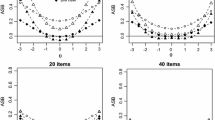Abstract
Consider vectors of item responses obtained from a sample of subjects from a population in which abilityθ is distributed with densityg(θ‖α), where theα are unknown parameters. Assuming the responses depend onθ through a fully specified item response model, this paper presents maximum likelihood equations for the estimation of the population parameters directly from the observed responses; i.e., without estimating an ability parameter for each subject. Also provided are asymptotic standard errors and tests of fit, computing approximations, and details of four special cases: a non-parametric approximation, a normal solution, a resolution of normal components, and a beta-binomial solution.
Similar content being viewed by others
References
Andersen, E. B. (1972). The numerical solution of a set of conditional estimation equations.Journal of the Royal Statistical Society, Series B, 34, 42–54.
Andersen, E. B. and Madsen, M. (1977). Estimating the parameters of a latent population distribution.Psychometrika, 42, 357–374.
Balker, J. T., Krasnoff, A. G. and Peaco, D. (1981). Visuo-spatial perception in adolescents and their parents: theX-linked recessive hypothesis.Behavior Genetics, 11, 403–413.
Bock, R. D. (1983). The Discrete Bayesian. In H. Wainer and S. Messick (Eds.),Principals of Modern Psychological Measurement. Hillsdale, New Jersey: Erlbaum.
Bock, R. D. and Aitkin, M. (1981). Marginal maximum likelihood estimation of item parameters: an application of an EM algorithm.Psychometrika, 46, 443–459.
Bock, R. D. and Kolakowski, D. F. (1973). Further evidence of sex-linked major gene influence on human spatial visualizing ability.American Journal of Human Genetics, 25, 1–14.
Bock, R. D. and Lieberman, M. (1970). Fitting a response model forn dichotomously scored items.Psychometrika, 35, 179–197.
Christofferson, A. (1975). Factor analysis of dichotomized variables.Psychometrika, 40, 5–32.
Day, N. E. (1969). Estimating the components of a mixture of normal distributions.Biometrika, 56, 463–473.
Deely, J. J. and Lindley, D. V. (1981). Bayes empirical Bayes.Journal of the American Statistical Association, 76, 833–841.
Dempster, A. P., Laird, N. M., and Rubin, D. B. (1977). Maximum likelihood from incomplete data via the EM algorithm (with discussion).Journal of Royal Statistical Society, Series B, 39, 1–38.
Dempster, A. M., Rubin, D. B., and Tsutakawa, R. K. (1981). Estimation in Covariance Components Models.Journal of the American Statistical Association, 76, 341–353.
Kendall, M. and Stuart, A. (1979).The Advanced Theory of Statistics, Volume II. New York: Macmillan.
Laird, N. M. (1978). Nonparametric maximum likelihood estimation of a mixing distribution.Journal of the American Statistical Association, 73, 805–811.
Lord, F. M. (1969). Estimating true-score distributions in psychological testing (An empirical Bayes problem).Psychometrika, 34, 259–299.
Lord, F. M. and Novick, M. R. (1968).Statistical Theories of Mental Test Scores. Reading, Mass.: Addison-Wesley.
Louis, T. A. (1982). Finding the observed information matrix when using the EM algorithm.Journal of the Royal Statistical Society, Series B, 44, 226–233.
Muthén, B. (1978). Contributions to factor analysis of dichotomous variables.Psychometrika, 43, 551–560.
O'Connor, J. (1948).Structural Visualization. Boston: Human Engineering Laboratory.
Ramsay, J. O. (1975). Solving implicit equations in psychometric data analysis.Psychometrika, 40, 361–372.
Rasch, G. (1980).Probabilistic Models for Some Intelligence and Attainment Tests. Copenhagen: Danish Institute for Educational Research, 1960. Chicago: University of Chicago Press, (reprint).
Rigdon, S. E. and Tsutakawa, R. K. (1983). Parameter estimation in latent trait models.Psychometrika, 48, 567–574.
Sanathanan, L. and Blumenthal, N. (1978). The logistic model and estimation of latent structure.Journal of the American Statistical Association, 73, 794–798.
Sörbom, D. (1974). A general method for studying differences in factor means and factor structures between groups.British Journal of Mathematical and Statistical Psychology, 37, 222–239.
Stroud, A. H. and Sechrest, D. (1966).Gaussian Quadrature Formulas. Englewood Cliffs, New Jersey: Prentice-Hall.
Zimowski, M. (in progress).Implications of item difficulties for visuo-spatial information processing. Doctoral dissertation, Department of Behavioral Sciences, University of Chicago.
Author information
Authors and Affiliations
Additional information
The author would like to thank R. Darrell Bock for his comments, suggestions, and encouragement during the course of this work.
Rights and permissions
About this article
Cite this article
Mislevy, R.J. Estimating latent distributions. Psychometrika 49, 359–381 (1984). https://doi.org/10.1007/BF02306026
Received:
Revised:
Issue Date:
DOI: https://doi.org/10.1007/BF02306026




